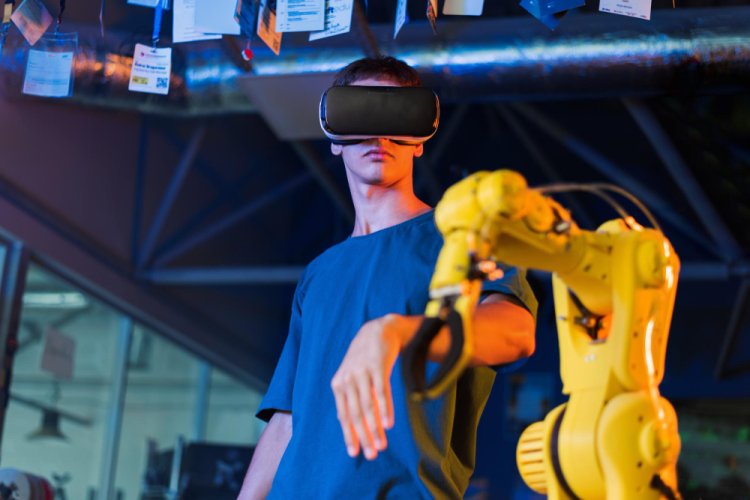Improving Worker Safety with Virtual Reality Training in Manufacturing Automation
Improve worker safety in manufacturing automation with immersive virtual reality training. Enhance hazard identification, emergency response, and skills retention while reducing costs and downtime.

In the fast-evolving world of manufacturing, worker safety has become a primary concern, especially with the integration of advanced technologies. As manufacturing automation continues to increase productivity and efficiency, the complexity of these systems also presents new challenges for worker safety. Ensuring that workers are adequately trained to handle automation systems, identify potential hazards, and respond to emergencies is more critical than ever. Traditional training methods, though effective, are often limited in their ability to replicate high-risk environments safely. This is where virtual reality (VR) in manufacturing plays a transformative role, offering a solution that provides immersive, risk-free training experiences for employees.
By integrating immersive virtual reality in manufacturing, companies are opening up new avenues for enhancing worker safety. This innovative technology allows workers to experience realistic training scenarios without being exposed to the risks associated with real-life environments. Virtual reality offers a hands-on, interactive approach to training that can be tailored to various manufacturing processes, from operating machinery to emergency response protocols. The result is a safer, more prepared workforce, capable of navigating complex systems with confidence and efficiency.
1. The Role of Virtual Reality in Manufacturing Safety Training
- Immersive Learning Experience: Virtual reality offers an interactive and engaging training environment that simulates real-world scenarios, allowing workers to experience the complexities of manufacturing automation without actual exposure to hazards.
- Realistic Hazard Identification: VR-based training helps workers identify potential risks in their environment, such as machine malfunctions, system failures, or unsafe working conditions, without putting them in harm's way.
- Emergency Response Simulation: Workers can practice emergency protocols and responses to critical situations, such as equipment malfunctions or fires, preparing them to act swiftly and decisively in real-life emergencies.
2. Cost-Effectiveness of VR Training for Worker Safety
- Reduced Training Costs: While traditional safety training requires physical materials, equipment, and instructors, VR training significantly reduces these expenses by providing a digital environment that can be used repeatedly without extra costs.
- Minimized Downtime: Since VR training can be conducted without interfering with production schedules, there is less disruption to the manufacturing process, resulting in minimized downtime and more efficient use of resources.
- Scalable Training Solutions: VR training modules can be easily scaled to train a large number of employees across different locations, ensuring that all workers receive the same high-quality safety education.
3. Enhancing Engagement and Retention through VR Training
- Active Participation: Unlike traditional classroom-based training, VR engages workers by allowing them to actively participate in realistic scenarios. This engagement leads to better knowledge retention and a deeper understanding of safety protocols.
- Repetition and Practice: VR training allows workers to repeat tasks and scenarios as often as necessary, helping them improve their skills and boost their confidence before handling real-world systems.
- Personalized Training Paths: VR training can be customized to suit the specific needs of each worker, ensuring that training is relevant and effective for different job roles and experience levels.
4. Improving Post-Training Performance and Long-Term Safety
- On-Demand Access for Refresher Courses: VR-based training can be made available on-demand, allowing workers to revisit important safety concepts or refresh their knowledge as needed.
- Measurable Outcomes: With the ability to track progress and performance within the virtual environment, VR training provides measurable outcomes, helping employers identify areas of improvement and ensure that workers are well-prepared for the job.
- Continuous Learning Opportunities: As manufacturing automation technologies evolve, VR can be continuously updated with new scenarios, allowing workers to stay informed about the latest safety protocols and system advancements.
Conclusion
Incorporating virtual reality into manufacturing automation training offers numerous benefits, particularly when it comes to worker safety. With its ability to provide immersive, realistic training experiences, VR equips workers with the skills and knowledge needed to navigate complex systems and identify potential hazards without the risk of real-world exposure. As manufacturing continues to evolve, the integration of VR in safety training will become increasingly essential, not only for improving safety outcomes but also for enhancing worker engagement, retention, and overall productivity. By embracing this innovative technology, manufacturers can ensure a safer, more prepared workforce, ultimately contributing to the success and longevity of their operations.
What's Your Reaction?
















